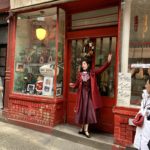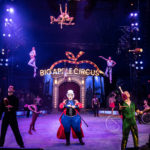This is a repost of a story that I recently posted over at The Broad Side. I am in the process of interviewing several survivors and many children of survivors for a project and I will be posting some of their stories. We must never forget the atrocities that occurred a mere 70 years ago and we must make sure that no one else ever forgets. It was an honor to meet Esther Geizhals and she assured me that her story must be shared, along with everyone else who lived through it. These stories of a mass genocide of an innocent people must be told. The photo above is a picture of the only one of Esther Geizhal’s mother left. She was taken from her during the Holocaust.
It’s hard to believe that it’s been nearly seventy years since the Holocaust. For survivors near the end of their lives, it is more important than ever to tell their stories. There are still people who deny that the Holocaust ever happened, and their ignorance leads to hatred and resentment, so recording them is one way of countering the lies of those who would deny history.
According to the Jerusalem Post last year, some 12,000 victims of Nazi atrocities died in 2011 and, according to data by the Foundation for the Benefit of Holocaust Victims in Israel, at least one survivor in Israel dies every hour. The number is far greater if you look at it globally. Organizations like the American Defamation League and the Shoah Foundation at UCLA are making sure that stories get recorded and that their legacies never die.
For many who survived, they have lived in pain and their memories of their Holocaust experiences remain vivid. Esther Geizhals is one of those survivors. She is an example of a strong Jewish woman who has endured much and is now making sure that no one has to experience the pain that she suffered.
She was born in Lodz, Poland in 1929 and still remembers today a particularly dark period of her life like it was yesterday. Her memory for detail is undeniable.
Prior to the war, she had a childhood full of love, happiness and adoring parents who were hard-working owners of a fruit & vegetable store. There was anti-Semitism where they lived but they had a normal life. She, like everyone else, had no idea what lied ahead. It proves that you never truly know what’s around the corner.
Lodz Ghetto: 1940-1944
After the Germans invaded Poland in 1939, her family lost their store and was required to stay in the Lodz Ghetto with 230,000 other Jews a year later. Conditions went from bad to worse very fast and she went from not knowing what a war was to being thrust into one. She remembers standing in line for bread, and then being dragged out of the bread line by the Polish. Her family started to suffer right away. She saw people dying from starvation in Lodz. There was no water, no coal, no sanitary means. They no longer went to school.
Life changed just like that. “They took everything from us. Everyone had a ration card for food, and you only got it if you worked. There was a black market but no one had money. The conditions were awful,” says the now-84-year-old Geizhals. “There was no coal to burn. People broke furniture to burn a fire. They put three to four people into one room. They closed the schools soon after for Jewish school. Jews studied under cover, learning Yiddish and Hebrew.”
Geizhals went to work at age 11 in a factory where they made dresses. Her little brother was too young to work. Her family hid him when the police came, or they bribed them not to come to their home. They lived in constant fear and starvation during the five years they were inside the ghetto. There was a nightly curfew at 8 p.m. She was sure her mother took her portion of bread and gave it to her. There just wasn’t enough food. “We spent nights praying and hoping the war would end. People were dying all the time. ‘Selections’ were taking place all the time,” Geizhals remembers.
Transports began/Liquidation of ghetto
In 1942, there was a big “selection” and the German soldiers took her grandmother away, as well as her young aunt who was 18. Geizhals never saw them again. It was later reported that they were taken to Belzec Death Camp and were killed instantly. Her mother knew she wouldn’t see her family again. Geizhals remembers her mom saying, “You’re lucky you have me still, but I won’t see my own mother again.” She was heartbroken and it pained Geilzhals to watch.
At the end of the five years, the Germans liquidated the ghetto, not leaving any signs of what had taken place. The starvation, the torture…it was as though it never happened.
August 22nd , 1944- Auschwitz
Geizhals and her family were transferred to Auschwitz extermination camp. They were taken in cattle cars. Here’s what she remembers:
“There was nowhere to sit. The ride was two days and two nights, standing up. No food, no water. There was a pail to go to the bathroom. They came to Auschwitz and everything was rush, rush, rush. ‘Schnell, out, out.’ The soldiers with the German shepherds and the inmates helped us out. The men and women had to separate. I was left with my mother and brother. They lined up singularly.”
Josef Mengele, the SS officer known as the “Angel of Death” who ran the human experiments at Auschwitz, deemed Geizhals fit for work and sent her to the right.
“My mother saw a neighbor’s little girl standing alone on the platform and took her hand. The child was terrified. Mengele asked her if she was her child. She nodded and he motioned her to the left. My brother, Pinkas, was frail. By this time, he was suffering from TB, so he, too, was motioned to the left. The soldier looked at me, I was 14, and he motioned me to the right. I started to cry, I wanted to go with my mother. Out of nowhere, a Jewish inmate came over and told me not to run. She stood in front of me and wouldn’t let me move.” Geizhals knew that this woman had saved her life. She has never forgotten her.
Geizhals remembers being corralled into a shower and having her head shaved. She later found out that her mother and Pinkas were exterminated in one of Auschwitz’s seven gas chambers. They gave her a dress two sizes too big, pink like a party dress, and a pair of high heels. They disinfected her with powder, like a dog. When she came out, she saw her father and he didn’t recognize her. They spoke a few words. They took her away to a barrack for six weeks. She remembers the cold, the hunger, missing her family.
Geizhals remembers standing for hours in the cold. Her feet were frozen to the ground from the high heels, full of blisters. There was no work for her. The end was near. They used to go to a place and pick up stones from here to here, just to pass the time and to be torture. She remembers the beating, the starvation, and not having enough clothes.
A very lovely woman named Paula took her under her guard. Geizhals cried all the time, and the woman took care of her. She rubbed her back so she’d be warmer. Paula’s little sister was jealous that she paid attention to her, but then they got sent away in a selection and were separated. She still thinks of her.
She has one picture of her mother that was taken when she was pregnant. Geizhals took it from her aunt after the war and hangs on the wall of her home today.
Bergen Belsen
After six weeks, Geizhals, then 15, was transferred to Bergen Belsen concentration camp. She doesn’t remember going to Bergen Belsen. The conditions were too horrible; she’s erased them from her memory. The camp had no room for them so the Germans put her in a tent. She remembers sleeping on snow and ice and they gave her a blanket: “All I had was that blanket. I was a complete skeleton. One night, I slept very close to a Hungarian woman for her body heat. She read my palm and told me to keep strong and that I would survive. When I woke up the next morning, she was dead next to me.”
Rochlitze Concentration Camp
In December, Geizhas was sent to Rochlitze concentration camp in Czechoslovakia. This was better because they were now placed in a building. They slept on the floor and they were taken out to work in factories. She was there for six to eight weeks.
March 1945: Dead March in Czech
Towards the end of the war, Geizhals and thousands of other survivors—malnourished, sleep-deprived, and barely alive—were forced to walk for miles and miles to railway stations to be transported to other camps so that the SS could destroy evidence of their camps. Geizhals remembers: “We were walking skeletons, drinking snow in place of water. We had no clothes. I had torn away a piece of blanket to cover my feet and they beat me for destroying German property. People were dying all around me. We walked from village to village. If we were lucky, families let us sleep in the bunks. After a few weeks without food, the clovers came out in the grass and we would eat them. I never saw a glass of milk in all those years — important years in the growth development of a young girl. We were a group of five girls who didn’t resemble humanity, and we slept in the high loft with the pigs and cows in a barn.”
“One night, the group stopped to spend the night at a barn and we hid under the hay in the loft. When the guards called everyone the next morning, we didn’t go down. We knew the Nazis would shoot us if they found us, but they didn’t look and moved on.”
“We came to a village and told them they were Polish girls and had run away from a concentration camp. The Czech families took each one of us home. We were dirty. We had lice and had to be cleaned. They fed us and we all had diarrhea from not eating for weeks. They gave us bread and fresh clothing. They kept us there until the war ended. “
End of War
After the war, Geizhals managed to return to Lodz, where she was reunited with her father. He remained behind in Poland, and, with an uncle, she smuggled her way to a displaced persons’ camp in the American zone in Germany, where she met her husband, Benek Geizhals, another survivor. He was eight years older. He got papers to come to America and asked her to come with him. They went to the American Embassy in Frankfurt and told them they wanted to go together. The American Consul said to her, “Tomorrow is Thanksgiving in America. It’s a wonderful holiday where we give thanks for everything we have, and we would love to have you.” He put her on a list for a youth group and told her not to write that she had family that survived on the application. Within a few weeks, she was on a ship to America.
Coming to America
“On Valentine’s Day in 1947, when I was seventeen, I came to America,” says Geizhals. “That’s when my life began. I love this country with all my heart.”
She’s never felt anti-Semitism in America. “It’s paradise here. I’m so grateful. It takes a survivor to appreciate what we have here.” She married at age 18 and then found a job right away at Henri Bendel’s. She was a finisher of beautiful dresses, working for Claire McCardel. She was in the union. Her late husband was an activist. He had a printer in Krakow and came here without the knowledge of the language, yet he opened a printer. They had three children.
Moving Forward
The Geizhals family created a life for themselves in New Hyde Park, where they raised three children. Their eldest son, Benjamin, is an attorney on Long Island; Michael, the middle child, is an accountant and lives with his family in Israel; and Jacqueline is a supervising nurse who lives in New Rochelle. Benek died 12 years ago, and Geizhals moved to Larchmont, New York, where she remains very close to her children and nine grandchildren.
Her husband was an activist, working for the Democratic Party and supported Israel. He was determined to teach the next generation after the Holocaust, so she is taking up where he left off after he died 15 years ago by making a point of telling her story, as often as she can. She tours schools, synagogues, Jewish Community Centers.
“I’m one of the youngest survivors, and I’m eighty-two. We’re dying out. My only wish is that people remember us.”
She then adds, forever haunted, yet grateful for what she has, “The pain of what happened will always be with me.”








 Follow
Follow





Speak Your Mind